My recent collage creations combine these cut up bird prints and my own mono-print backgrounds. The bird lithograph colors have a vintage patina that I love. They are subdued, maybe a little faded with age, but still have enough contrast. The silhouettes are graceful, and the textures are meticulously rendered. The mono prints are very gestural and have a lot of movement and so they create a kind of frenetic environment for the birds.

“The Birds of North America” by John J. Audubon, is a very well-known collection of prints based on a folio of original engravings by Audubon that date from about 1830. Those originals are very large, rare and worth a gazillion dollars. The humble yet heavy book that came into my possession has many editions and was printed and given away as an insurance premium around the middle of the 20th century. I discovered when I ordered an additional book on Ebay, that they are readily available, and the printing date matters. The 1941 edition is well printed on thick paper and the colors are smooth and consistent. The 1946 edition suffers by comparison. There had been a war, the paper was thinner, the register is off on many of the plates and the inks are all spotty.
Audubon was a master painter/engraver and I have come to appreciate him more as I study and devour the prints in these books. Although he has been criticized by ornithologists for his inaccuracies in some of the bird anatomy, and for killing and posing dead birds to paint them, to me the images are strikingly beautiful, perfect to up-cycle and inspired me to go in a completely new direction with my work.
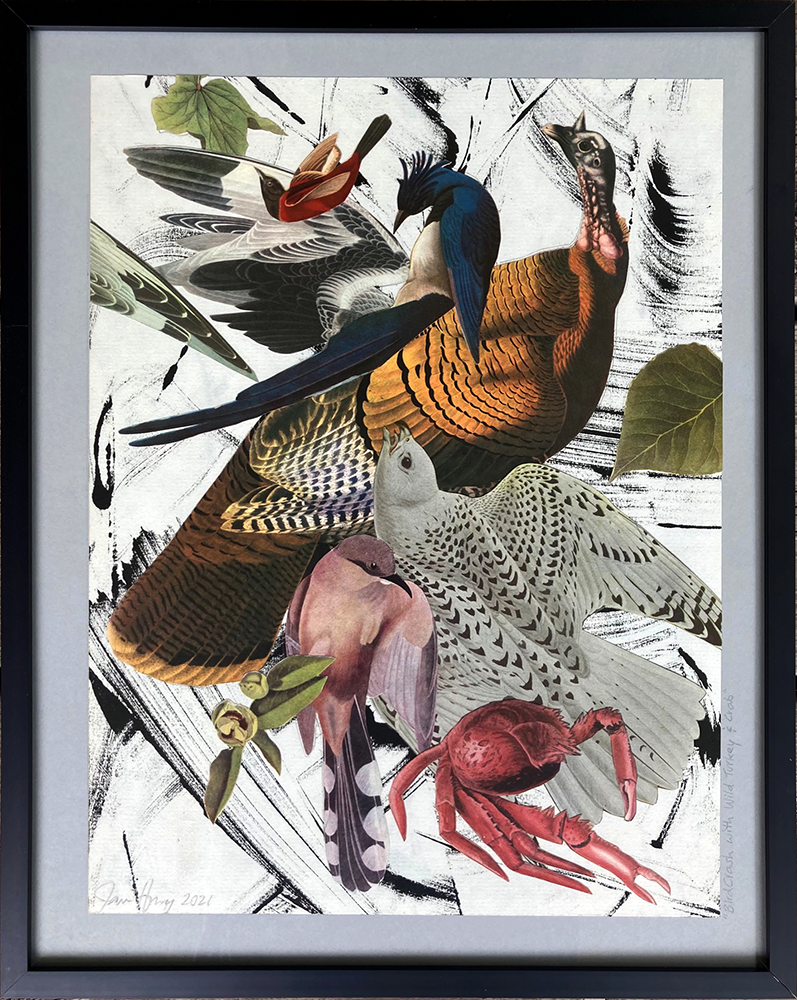
© 2021 Janice Hovey
The process of cutting the intricate shapes by hand, as any analogue collage artist will tell you, is very meditative and therapeutic. As I continue to cut, combine, and create more experimental compositions, I have started to realize that these are not just pretty juxtapositions of bird shapes. I think, they tell a story about climate change. The birds, in many of the collages are all darting, flapping, and crisscrossing as if looking for somewhere to go. They appear to be “crashing” into each other in a crowded, ink-streaked sky, as they are frantically trying to flee. The mostly improvised expressions on the bird faces, when taken out of the context of the serene backgrounds that Audubon created, are ones of vulnerability, anxiety and sometimes violence, and many of his prints depict bird carnage (birds of prey doing what they do). There is an ominous underlying feeling of unease that emerges. Alfred Hitchcock certainly recognized that birds could appear beautiful and majestic and at the same time threatening and violent. Do they sense an impending doom that they cannot control? And will they look for revenge or just safety? I will keep making and maybe arrive at an answer, or maybe I will find another old book of fish prints and I will go swimming in another direction.

© 2021 Janice Hovey

Could it, would it wear a hat? Should it, could it add some gloves? I think so and today I am adding another ensemble.
Is it inconceivable that the birds drawn by John Gould’s[1] team and John James Audubon would dress for success? After all, the male Bower bird creates an elaborate landscape in an effort to attract a female.
What accoutrements would John Gould’s birds, reproduced in the 40s or 50s, decide to wear? Perhaps they would fly off their perches in the frames on the wall and find furs, gloves and hats from a 1930s magazine advertising women’s dress patterns that was lying about the house.
Flights of fancy? Perhaps, but what about in a million years. In the 1980’s another classification system emerged called cladistics which “aims to identify and take account of only those shared characteristics which can be deduced to have originated in the common ancestor of a group of species during evolution, not those arising by convergence.”[2] To help get the concept across the following puzzler is presented: which one of the following three does not belong together – a cow, a salmon, and a lungfish? Turns out it’s the salmon because both the cow and the lungfish have a lung and an epiglottis (a flap on the tongue that helps with swallowing). [3]
So, if birds
are related to dinosaurs,[4]
and humans have similar brain wiring to
birds[5]
and both birds and humans are attracted to beauty and embellishment, then why
wouldn’t birds add hats, stoles, gloves and purses?
[1]https://www.britannica.com/biography/John-GouldJohn Gould 1804 – 1881
[2] https://www.lexico.com/definition/cladistics
[3]https://www.researchgate.net/publication/282022631_The_salmon_the_lungfish_or_the_coelacanth_and_the_cow_A_revival/link/5609c7e108ae576ce63f69d0/download
[4] https://www.osc.org/are-birds-dinosaurs-looking-into-the-dino-dominated-past/
[5] https://phys.org/news/2013-07-birds-humans-similar-brain-wiring.html
]]>Musical accompaniment to this post by Aimee Mann
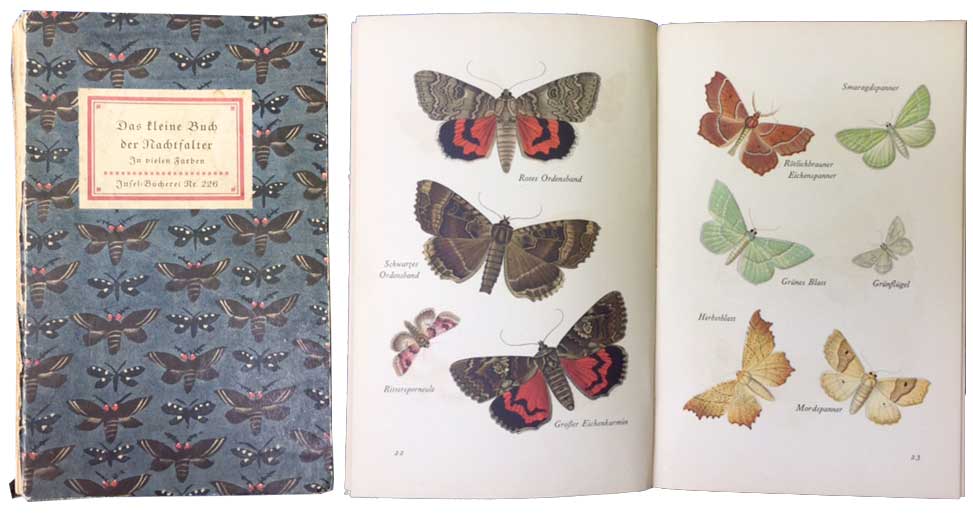
I picked up this sweet little book at a used book store for 5 bucks about 25 years ago. It appears to be a field guide to moths written in German. There is no copyright date or publisher information, and I don’t read German, so I have no idea how the book came to be. It is one of those possessions that I never consciously look for or have a spot where I keep it. I come across it now and then, either in a stack of papers or on a shelf that I haven’t looked at in months. I enjoyed looking at it when I would accidentally unearth it and ponder briefly what I was going to make with it, only to return it to its hiding spot.
The colored lithographs are really vivid and beautifully rendered, but the problem with these delicate and detailed illustrations is that they are on both sides of the paper, so to cut into one I would have to sacrifice others that are on the flip side of the page. After 25 years of tossing this little book around I finally cut it up one day last summer and started making. I made 2 collages and will continue with the series, probably until the images are used up. The flood gates opened, well, sort of. I suppose one could argue that I should have just left it intact as a book, but the images are too beautiful not to be on display.
To me the moral of this story is that sometimes you have to live with something for a long time before it speaks to you and tells you what to do with it. So, Marie Kondo, am I following your philosophy? Save the things that give you joy, regardless of how futile it might seem? Would she approve and do I care? Different rules apply to those of us who are makers.
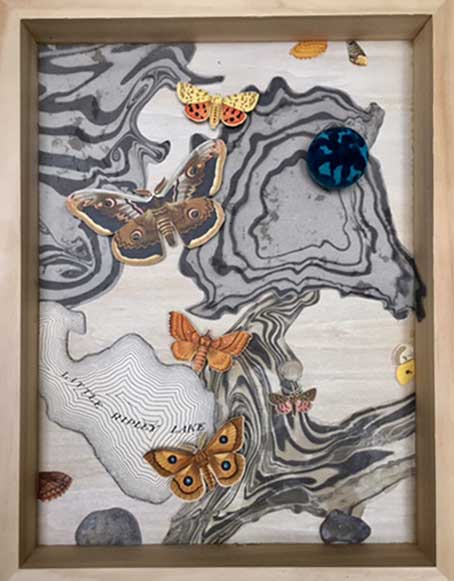
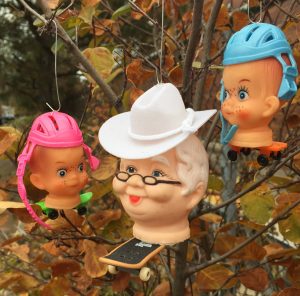
So many doll parts (like Courtney Love’s song) out and about. The heads were acquired individually as components for making your own creations and found their way into my “doll parts file cabinet”. The helmets are from young Barbie relatives. The matching elbow and knee pads might end up as bead options for some other piece in the future. Grandma’s grey bun required some embellishment and the ten-gallon hat fit nicely.
]]>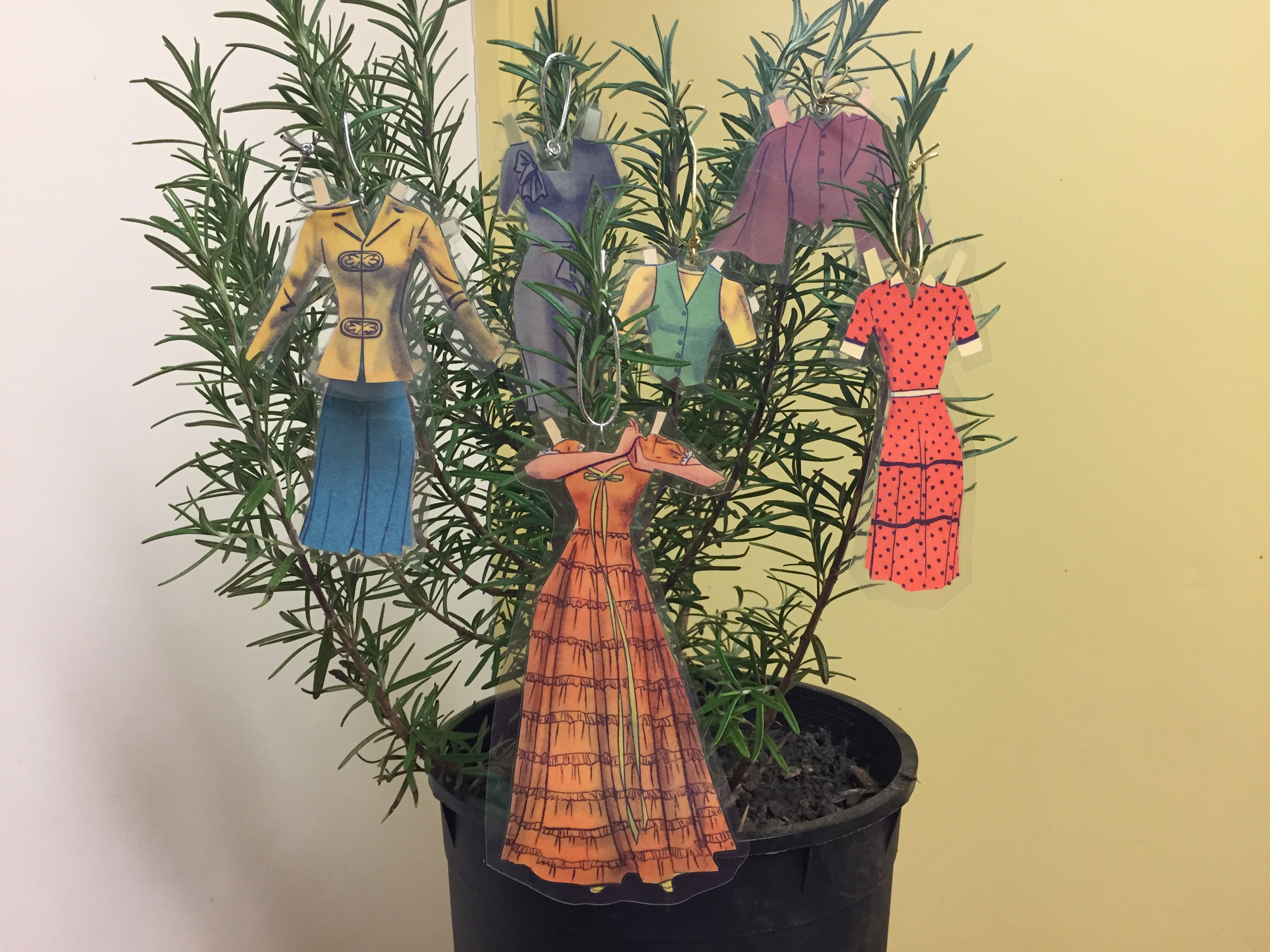 I started sewing doll clothes around seven years old and took all the sewing classes offered in my high school during the 1970s. I learned by doing that polyester fabric responded to cutting, folding, ironing very differently than cotton or wool. Through the years I saw polyester and other such materials blended with cotton and wool to increase flexibility and longevity. I have also learned that the longevity advantage of plastics in all its forms is becoming a societal problem-it lasts a very long time and is piling up on the planet (https://www.instagram.com/surfersagainstsewage/). I try to consider many options before I select new plastic.
I started sewing doll clothes around seven years old and took all the sewing classes offered in my high school during the 1970s. I learned by doing that polyester fabric responded to cutting, folding, ironing very differently than cotton or wool. Through the years I saw polyester and other such materials blended with cotton and wool to increase flexibility and longevity. I have also learned that the longevity advantage of plastics in all its forms is becoming a societal problem-it lasts a very long time and is piling up on the planet (https://www.instagram.com/surfersagainstsewage/). I try to consider many options before I select new plastic.
By contrast, vintage paper is currently abundant, but fragile and will not last forever. Vintage magazines have far more hand-drawn images than later eras. I was initially reluctant to from them until I shared this feeling with a good friend who is a historic preservation professional who suggested that I release those images to the world. That concept freed me and the images.
The Turnabouts, produced during the “Golden Age of Paper Dolls” from the 1930’s through the 1950’s, needed more thought. These American mid-century images of woman’s fashion in the muted colors are printed on both sides. The paper dolls had been cut and saved for over 60 years, probably by women in the same family. In this instance embalming – to preserve from oblivion; keep in memory – is my intention. https://www.womenshistory.org/articles/history-paper-dolls-and-popular-culture
Barbie appears to have been a disrupter and an adopter of paper doll technology. The historians write that “Barbie may be credited or condemned for the decline in popularity of paper dolls in the 1960s, yet in the 1990’s Barbie was one of the most popular paper dolls among children and collectors alike.” (http://www.opdag.com/history.html and http://www.dollkind.com/paper-doll.shtml). 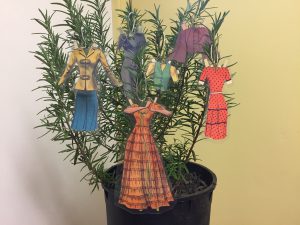
I guess most vintage clothes have a history, which is part of their appeal. They are usually one of a kind and never go out of style. This jacket is not only an awesome looking piece but it also has a great history. On the white shoulder panel in back are signatures scrawled in blue ink. They are the names of the band members from “It’s a Beautiful Day”. They were a band from 1960s San Francisco with one hit song. White Bird is that song and if you look it up on U-tube and are as old as I am, you will probably recognize it. It’s kind of a soft, folksy, rock ballad that sounds very much like the San Francisco sound in the 60’s. Almost nobody knows who the band is these days and anybody who isn’t over 50 has never heard the song, so the story is lost on them.
I imagine a young guy wore this jacket to the concert and waited around to meet the band afterwards and they all signed the back of his amazing jacket. It’s such a period piece, an unmistakable emblem of Americana, a hippie’s dream, a jacket that might have been at Woodstock, it screams of the era from which it came. Ban the bomb, far out, and groovy!
Turns out I didn’t saunter around in it as much as I had hoped. It’s too big for me (a mens 40), and the leather is thick and kinda heavy, and it’s really not very warm. I wore it on a few occasionswhen I wanted to display how “artsy” I was, but the long red fringe made it highly difficult to use my arms for anything useful, like reaching, driving or carrying a bag. So, it has hung in my closet for about 25 years, occasionally coming-out for a costume or a show-and-tell, and it is with a certain sadness that I realized it is time to let it go. I can no longer “pull it off”. For that matter I can no longer pull off wearing my vintage clothes in general. There comes a point as one ages when you just look like an old person wearing old clothes. I fear I have reached that point. There are a few classic pieces I will not part with, like some rhinestone sweaters, a 40’s tailored jacket that was my aunt’s, and a gorgeous blue fox collar that belonged to my grandma, but for the most part it is the end of an era.
I hope selling the jacket will make me feel better. I suppose it should be in a glass case at the Rock and Roll Hall of Fame, but I don’t have the motivation to make that happen. It should be seen, it should be out and about, swinging on the shoulders of a much younger person who frequents hipster bars and clubs. It should be worn to conjure up feelings of nostalgia from all the baby boomers who still remember the freedom of youth. So good bye cool fringe jacket, I will be just fine in my practical, black, North Face, mid-weight, fleece, zip-up!
The Fringe Jacket and other articles of vintage clothing will be available at the Green Art Collective booth at Randolph Street Market, Dec. 15-16.
]]>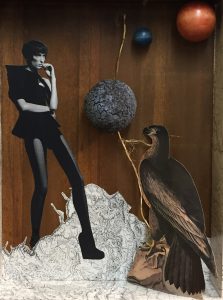
The Hunter’s Moon rose on October 24 and I was fortunate to see it rising over Lake Michigan. Moon rises always provide a much-needed perspective. I got to the lake about 6:45 and the moon was already above the horizon. When I go home from work I dressed for cold – kept on my tights, added jeans, cashmere, under armor, and a mustard colored 90s down coat, headband and gloves. I knew the breeze off the lake would be cold. I also, brought beer and scotch. Threw in some beach chairs. My friends had arrived to see the moon begin its journey so by the time I got there they were all leaving, due to that cold breeze. I ended up drinking a beer by myself sitting on the dock staring straight at the moon. Loved everything about it – the sound of the waves and the fact I could barely hear the planes, the smell of the lake, the light, the cold (since I had dressed for it), the solitude (though if my friends were still there that would have been a fine alternative), my memories of other moon rise and the sense of celestial time. When I returned home I could visit the moon from my back porch. To top off the event I sipped a wee bit of that scotch before I put that bottle away, like an old lady in a stone house in the Outer Hebrides. I checked for the date of the next full moon- the Full Beaver Moon is November 23, Thanksgiving night.
That night a friend wrote, “I love that we’re just a hop and a skip down the road from these opportunities to connect to the universe.” Tonight, as I check out the moon as it rises behind the cottonwood tree I am reminded of this piece I finished a few months ago.
]]>There was a huge gallery devoted to gorgeous bead work from many different countries. As I wandered slowly, the marriage adornments, warrior tunics, cloaks, vessels, head and neck pieces, although different in many ways, blended somewhat seamlessly, held together by one shared objective — the desire to make things. There was another large gallery with probably over a hundred dioramas, all depicting daily life or traditional ceremonies that are essential to a particular culture. Many of the diorama displays featured dolls, textiles, masks, and other significant objects uniquely created to represent each different country of origin. Dozens of cultures, so different and so rich in heritage, but again, all sharing the distinctly human characteristic of wanting to make things. And not just things that are mundane or merely useful, but things that possess great beauty and show a high level of craft, representing a time, a place and often telling a story. I wondered how hard it would be to understand and grasp another culture’s true essence if we couldn’t see what its people make?
I know not everyone has the desire to create, at least not in the way I create. I have always loved making things, using my hands and creating decorative and/or functional objects with a variety of mediums. I have often looked down on what I make as being only “craft” and not “fine art”. I am educated enough to understand the difference. Lately, however, I have started to feel that maybe what I do as an artist and as a teacher has more significance than I give it credit. Maybe I need to value this deep-seated desire to be a “maker”, cuz if I don’t do it who will? Who will show us how important it is to pass on old traditions of craft and at the same time, cultivate an atmosphere to discover new ways of making as well? After all, this desire to create helps us to understand the human condition, gives us a common visual language and makes us more similar than different.
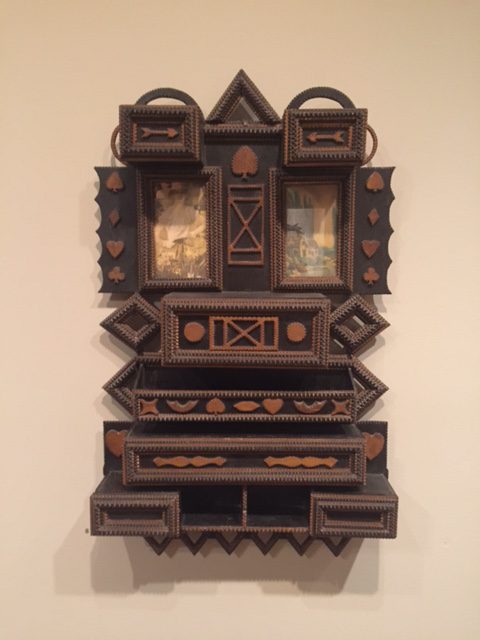
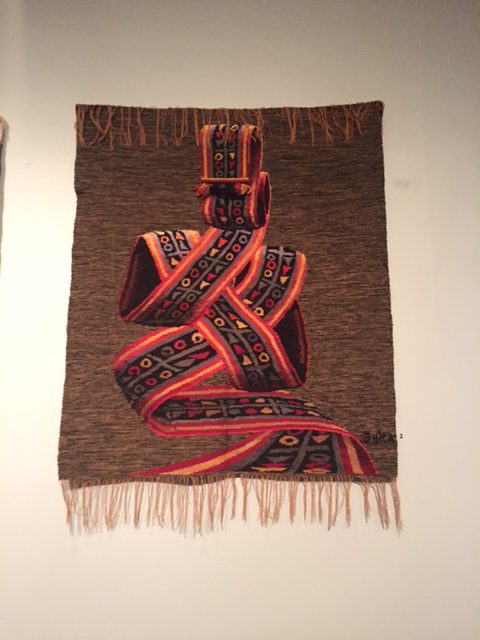
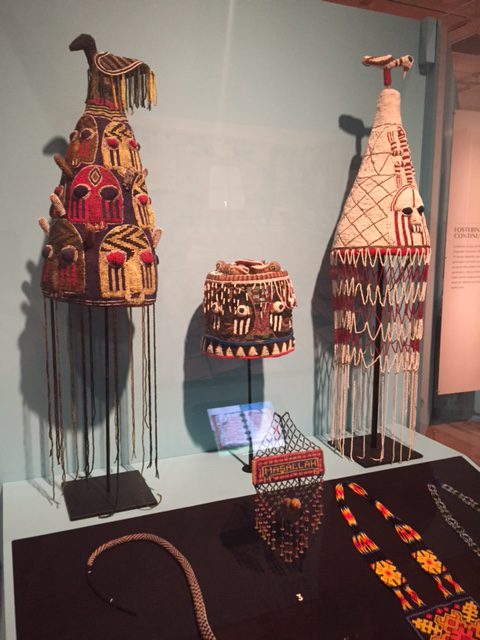
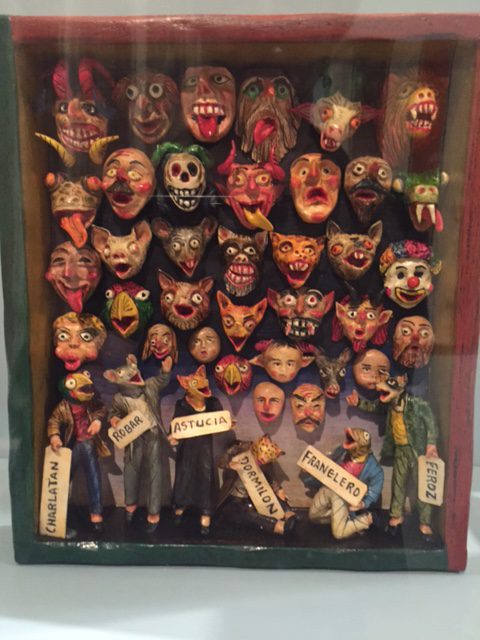
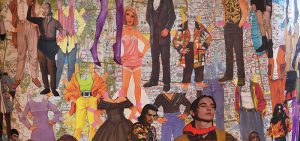
[contact-form-7]
This weekend I went back to a piece I set aside last year which I envisioned as “Clothes Continuum.” The inspiration is a paper doll set which looks like it is from the 80s or 90s. The boy and girl are average sized, white adolescents. The apparel might have been found in a Sears, Target or Walmart. The first thing I did with the paper dolls and clothes was organize the pieces (Instagram #kdickhut – Post 1) based on elements such as color, jewelry, and shoes. That exercise revealed less distinction between the clothes for the boy and the girl. I decided that the paper dolls would be best collaged in a circle, not a line with two different end points. I found a plastic Ikea vessel made in Italy at the Goodwill for a couple bucks. Wrapped it in a map of the USA and then added the paper dolls. That worked well for the Clothes Continuum story. But it needed fashion art. Fortunately, there is plenty of that in New York Times Style magazines. There is a lot more color among fashion models these days, however, not so much diversity of size.
I can see this piece being used as a clothing hamper or paper recycling bin in an adolescent bedroom. And speaking of today’s adolescents, Janice, my Green Art Collaborator, relayed a fascinating story during a happy hour gathering recently. Her 7th and 8th graders were filling out some form for school and they had to choose either male or female, a standard identity question. Some of the students asked, “Why are those the only choices?” Her response, “I get that your sexuality is feeling very fluid now but go with what you are feeling at the moment.” It’s a continuum.
]]>